Beaufort is a village and community located in the historic county of Breconshire. The settlement arose on the boundary of two parishes, Llangattock in Breconshire, and Aberystruth in Monmouthshire on the 1779 establishment of the Beaufort Iron Works by Edward and Jonathan Kendall, after whom the new settlement was first named. The village’s name derives from the fact that much of the local land was originally owned by the Duke of Beaufort. The border between Beaufort and Ebbw Vale itself is generally considered to be the Ebbw River which passes close to St David’s Church. Beaufort was transferred to the county of Monmouthshire in 1888, but for many years afterwards was referred to as Beaufort, Breconshire. The men of Beaufort, and neighbouring Rassau, who fell during all wars are commemorated on a modern war memorial, which is situated in Bethesda Church Memorial Garden, at Beaufort Rise, Beaufort. The memorial has no names as it was felt that it would be too easy to miss out people, which is understandable. However, there are several war memorials locally which do commemorate the fallen by name.
This webpage commemorates the men named on the war memorial which used to be located inside St. Andrew’s Church, in Beaufort. The memorial takes the form of a framed Roll of Honour and is now in the care of Brynmawr Museum. The memorial originally hung on the north wall of Saint Andrew’s (Anglican) Church on Beaufort Hill between Brynmawr and Ebbw Vale and commemorates its parishioners who fell during the Great War.
The Great War, 1914-1918
William Edward George Baker, Private, 2568, Monmouthshire Regiment. William was the son of William George Baker and Catherine Baker (nee Thornton), of 47, Harcourt Street, Ebbw Vale. He married Annie Jones in 1907 and the couple set up home at 43, Harcourt Street, Beaufort. William worked as a coal hewer prior to enlisting into the 3rd Battalion, Monmouthshire Regiment at Abergavenny. The battalion was mobilized at Abergavenny on 4 August 1914 attached to the Welsh Border Brigade, Welsh Division, before moving to Pembroke Dock. The Division then moved to Oswestry before moving to Northampton at the end of August. The Division moved to Bury St. Edmunds in December then in January 1915 moved to Cambridge, then in February 1915 the 3rd Monmouth’s left the Welsh Division and landed in France on 14 February 1915. Two weeks later the battalion joined 83 Brigade, 28th Division at Ypres. On 8 April the 3rd Monmouth’s relieved a French Division in the sector east of the Polygon Wood to begin its first tour in the trenches. The battalion was relieved four days later, and marched to billets in Ypres, then on 17 April relieved the 5th King’s Own in the front line, to begin a spell which would last for 17 days without relief. On 22 April, just to the north, the Germans launched the first gas attack of the war upon French Colonial troops at Gravenstafel, heralding the opening of the Second Battle of Ypres. The fighting remained to the north of Polygon Wood until 3 May, when the Germans widened their attacks and the Polygon Wood sector was evacuated by the 28th Division, which fell back on the G.H.Q. line at Potijze. Over the coming days their new positions were shelled mercilessly, then on 8 May the Germans attacked. Despite heavy losses the Division held firm and later that day three Companies of the 3rd Monmouth’s moved back into billets at Vlamertinghe, leaving B Company in the line. By now casualties had become so severe that on 10 May a Composite Battalion was formed from remnants of 83 Brigade, under Lt Col Gough, and proceeded to the G.H.Q. line at Potijze. William was killed in action here during the following day, 11 May 1915. The 31-year-old has no known grave and is commemorated on the Ypres (Menin Gate) Memorial, Belgium.
Ebenezer Bennett, Private, 20282, South Wales Borderers. Ebenezer was born at Beaufort in 1861, the son of Thomas and Ann Bennett. He married Elizabeth Nicholas in 1885 and the couple set up home at 30, South Street, Beaufort. Ebenezer worked as a coal hewer for many years prior to enlisting into the 10th Battalion, South Wales Borderers at Brecon soon after the outbreak of war. The battalion had been formed as one of two Gwent Battalions of the South Wales Borderers, especially to join the newly formed 43rd (Welsh) Division. Ebenezer had not been in uniform long when he took ill, and he died at Beaufort on 19 December 1914. The 51-year-old was buried in St. David’s Churchyard, Beaufort.
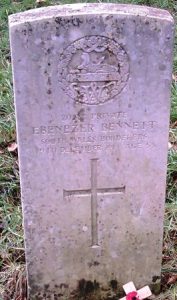
Stanley Francis Bevan, Private, 474377, Labour Corps. Stanley was the son of Thomas Bevan and Elizabeth Bevan, of 5, Williams Row, Beaufort. He worked as a coal hewer prior to enlisting into the Royal Monmouthshire Royal Engineers on 7 April 1913. Stanley was discharged from the army as medically unfit on 1 January 1915, having not served overseas, but re-enlisted into the 10th Battalion, South Wales Borderers. He was again recommended for discharge as medically unfit from the infantry, but was deemed as fit enough for home service, so instead transferred to the Labour Corps and was posted to France, joining the 62nd Company, Labour Corps. Despite his ill-health, Stanley almost survived the war, but sadly he contracted influenza and died just after the Armistice, on 14 November 1918. The 23-year-old was buried in Beaulencourt British Cemetery, Ligny-Thilloy, France.
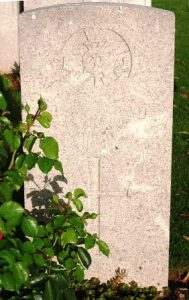
William Bevan, Private, 12609, South Wales Borderers. William was the son of Thomas and Hannah Bevan of 1, Glen View, Beaufort. He worked as a coal hewer prior to enlisting into the 4th Battalion, South Wales Borderers soon after the outbreak of war. The battalion formed at Brecon, before moving to Park House Camp, near Tidworth to join 40 Brigade, 13th (Western) Division, then moved to billets in Cirencester before moving to Woking in March 1915 for final training. On 29 June 1915 the Division sailed from Avonmouth for Mudros, before landing at Cape Helles, Gallipoli on 15 July 1915. Two weeks later the Division was moved to Anzac, to reinforce the Australian and New Zealand troops there, in readiness for a great assault on the Sari Bair Ridge, in conjunction with fresh Allied landings at Suvla Bay. The assault began on 6 August 1915 and raged over the coming days. The 4th SWB reached the Achyl Dere before assaulting, and seizing Damakjelik Bair, one of the ridges held by the Turks. The Turks counter-attacked on 9 August and terrible fighting raged throughout the day. The Division remained at Gallipoli over the coming months, as the fighting drew to a close, and suffered terribly when winter hit the peninsula, bringing floods and disease. The Division was finally evacuated to Mudros on 8 January 1916 before moving to Egypt, then on 15 February 1916 embarked at Suez, arriving at Basra on 4 March to join the forces being assembled to attempt to relieve the besieged garrison of Kut-al-Amara. William had not been in Mesopotamia long when he was killed in action on 9 April 1916. The 36-year-old has no known grave and is commemorated on the Basra Memorial, Iraq.
William James Brown, Private, 267818, Monmouthshire Regiment. William was the son of Margaret Brown, of 97, The Rise, Beaufort. He worked as an underground haulier prior to enlisting into the 3rd (Reserve) Battalion, Monmouthshire Regiment at Abergavenny on 19 October 1914. The battalion had formed at Abergavenny the previous month, then in February 1915 joined the Welsh Border Brigade, Welsh Division at Cambridge. In April 1915 the battalion joined 205 Brigade, 68th (2nd Welsh) Division at Northampton, before moving to Bedford in July. On 22 July 1916 William was drafted to France and was posted from the Infantry Base Depot to join the 2nd Battalion Monmouthshire Regiment, which by then was on the Somme attached to the 29th Division as the Divisional Pioneer Battalion. The Division had suffered terrible casualties at Beaumont Hamel, during its assault on Y-Ravine on 1 July 1916 and, although severely depleted, the Division remained in the line here over the coming weeks, in trying conditions. On 27 July the Division entrained for Flanders, detraining at Proven before relieving the 6th Division at Ypres. The Division held the line here over the coming weeks as it rebuilt its strength and the 2nd Monmouth’s worked hard on improving trenches and digging new communications trenches. The battalion then worked on the Menin Road, erecting elephant shelters, then on 4 October the Division was relieved and entrained south for the Somme once more, moving to Trônes Wood, before joining the latter stages of the Somme offensive. The Division wintered on the Somme, with the 2nd Monmouth’s working on road repairs around Montauban, then at Ginchy, Flers and Morval. The 2nd Monmouth’s moved into reserve at the end of December and moved to Fourdrinoy, where the men trained in infantry assault manoeuvres. On 12 January 1917 the battalion began marching back into the battle area, taking over positions near Morval, and began supplying working parties around Montauban once more. The Division then received orders to mount an attack, so at dawn on 27 January 1917 the 2nd Monmouth’s began work on two new communication trenches to connect the old front line to the new objectives. William was killed in action at some time during the day, probably due to artillery fire. The 27-year-old has no known grave and is commemorated on the Thiepval Memorial, France.
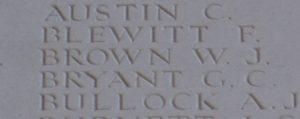
John Bull, Corporal, 20374, South Wales Borderers. John was the son of Joseph and Martha Bull, of 27, North Street, Beaufort Hill, Beaufort. He married Elizabeth Lavinia Freebury in 1902 and the couple set up home at 3, Cross Row, Rassau. John worked as a coal hewer for the Ebbw Vale Company prior to enlisting into the 11th South Wales Borderers at Ebbw Vale soon after the outbreak of war. The battalion was at Colwyn Bay attached to the 43rd (Welsh) Division. The Division trained in North Wales before moving to Winchester in the summer of 1915, where the formation became renumbered 113 Brigade, 38th (Welsh) Division. The Division began moving to France on 2 December 1915 and moved to the Nursery Sector near Fleurbaix for trench initiation alongside the Guards Division. The Division then held a sector of the line near Cuinchy before marching south to the Somme sector in June 1916 to take part in the assault on Mametz Wood. The first attack on the wood was launched on a two-battalion front on 7 July, but failed, and the Divisional Commander, Sir Ivor Philipps, was replaced before the Division attacked again on a two Brigade front on 10 July 1916. After two days of ferocious hand-to-hand fighting, the wood was cleared up to its northern edge, before the battered Division was relieved. It then took over a section of the front at Hébuterne before moving to the Ypres Salient and taking over the Canal Bank sector at Boesinghe. The infantry battalions of the Division then began carrying out the normal pattern of rotation in the trenches, four days in the front, four in support and four in reserve, whilst also working on trench improvement, digging new trenches, and carrying out regular patrols and trench raids. On 31 July 1917 the Division launched its famous assault on the Pilckem Ridge, capturing Iron Cross and reaching its objective of the Steenbeek. John was killed in action during the assault that day. The 37-year-old has no known grave and is commemorated on the Ypres (Menin Gate) Memorial, Belgium. His son, John Henry Bull, was killed at Antwerp during the Second World War.
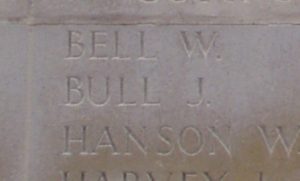
Worthy Bull, Private, 39838, South Wales Borderers. Worthy was the only son of Henry Bull and Kate Adelaide Bull (nee Bedford), of Clynderwen House, Beaufort. He worked as a shop assistant prior to enlisting into the Monmouthshire Regiment at Abertillery soon after the outbreak of war. Upon being drafted to France in the Spring of 1917, Worthy was transferred to the 2nd Battalion, South Wales Borderers, which was at Arras attached to 87 Brigade, 29th Division. In the Spring of 1917, the Division fought at the Battle of the Scarpe, which was part of the Arras Offensive, seeing heavy fighting around Monchy-le-Preux, and then moved further north to Ypres, initially to hold the line whilst other units had been withdrawn for specialist training, in readiness for the Third Battle of Ypres, which opened on 31 July 1917. The 29th Division went into reserve whilst the first attacks, the Battle of Pilckem Ridge, took place, then on the night of 14-15 August the 2nd SWB moved into the line facing Langemarck, ready to launch another offensive. On the following day the battalion reconnoitred the ground in front of them, and laid white tapes in No Man’s Land, to guide the attacking troops, and at dawn on 16 August 1917 the 2nd SWB launched an attack on Langemarck. The battalion successfully took its two objectives but had suffered 163 casualties. The Division then had another period out of the line to rest and refit before taking part in further fighting near Poelcapelle. Early in October 1917 the Division was relieved from the line at Ypres, and moved south to the Bellacourt area, to prepare to take part in the forthcoming Battle of Cambrai. The Division entrained for Péronne on 17 November, marching to a camp four miles out of the town at Haut Allaines, then by midnight on 18 November had reached Fins. On the following day the Division received its battle stores and detailed orders for the forthcoming battle, marching off via Gouzeaucourt to its assembly positions at Marcoing. The assault began at dawn on 20 November, but the Division suffered terrible casualties whilst attacking Masnières, on the Hindenburg Line. After wintering in the Cambrai sector, in January 1918 the 29th Division moved back to Ypres, taking up positions at Passchendaele Ridge again. To the south, the Germans launched the opening phase of their great offensive along the Somme front on 21 March 1918, then on 9 April launched the second phase along the Lys Valley. The 29th Division was relieved by the 41st Division that day and moved out of the line, before being rushed to positions at Les Haies Basses on the evening of 10 April. On the following morning the Division was hit by the Germans and the 29th Division was forced to withdraw, as they were flanked on the left. Worthy was killed in action during the fighting that day. The 25-year-old has no known grave and is commemorated on the Ploegsteert Memorial, Belgium.
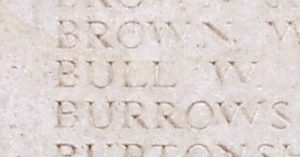
Frederick John Campbell, Private, 33768, Yorkshire Regiment. Frederick was the son of Police Constable Frederick Campbell and Elizabeth Campbell (nee Williams), of 67, The Uplands, Rogerstone. He lived in Beaufort prior to enlisting at Ebbw Vale into the Army Service Corps, but was then transferred to the infantry, first joining the Essex Regiment. Upon being drafted to France in the summer of 1917, Frederick was transferred to the 5th Battalion, Yorkshire Regiment. The battalion was attached to 150 Brigade, 50th (Northumbrian) Division and was rebuilding following heavy losses during the Arras Offensive of April and May. The Division moved to Ypres in October and took part in the Second Battle of Passchendaele, before wintering at Ypres. At the end of February 1918, the Division was relieved and moved into reserve, before being transferred to Demuin, in the St. Quentin Sector. The Germans launched the first phase of the Spring offensive along a stretch of the Western Front running south from Croisilles to La Fère on 21 March 1918 and the 50th Division was ordered forward into the line to help bolster the thinly stretched defences at Vraignes. The Division then took part in a gallant rear-guard action during the Actions at the Somme Crossings, and then at the Battle of Rosieres. After suffering terrible casualties, the Division moved north to Flanders to rest and rebuild, but on 9 April the Germans launched the second phase of their attack in Flanders, around the Lys Valley, and the Division was again caught up in desperate fighting before being relieved and moved south to join IX Corps on the Aisne, believed to be a much quieter area. This was unfortunately not the case, as the Division was hit hard by the third phase of the German attack here on 27 May 1918. The 5th Yorkshire’s were in the line when the Germans attacked, and the battalion was virtually annihilated. Frederick was 20 years old when he was killed in action during the fighting that day. He is buried in Vendresse British Cemetery, France.
Edgar Charles, Private, 88429, Machine Gun Corps. Edgar was the son of Edmund Charles and Jane Charles (nee Prosser), of Cwm Gwibedog, Beaufort. He worked as a building contractor at Beaufort prior to enlisting into the 4th (Reserve) Battalion, Welsh Regiment at Ebbw Vale on 25 February 1916 and was initially placed on the Army Reserve. Edgar was mobilised on 1 January 1917 and joined the battalion at Pembroke where he completed his training and was transferred to the Machine Gun Corps before being drafted to France on 6 May 1917, joining the 98th Company, Machine Gun Corps on 30 May. The Company was at Beuvry, attached to 98 Brigade, 33rd Division and was Stood To, ready to move at two hours’ notice when Edgar arrived. The Division was holding the Fontaine-les-Croisilles Sector, but at the end of June moved out of the sector into the Somme back areas, near Airaines, where it spent almost a month before taking over front-line positions on the Channel coast, near Bray Dunes, in the Nieuwpoort Sector. The intention was for the Division to launch an assault along the coast but following the failure of the army to break out at Ypres, the Division was rushed to the city, before taking over positions facing Polygon Wood by 25 September, joining the Passchendaele offensive. Over the coming days the Division saw terrible fighting for the wood, before being relieved, and moved to the Messines Sector the following month. Edgar was wounded at Messines soon after arriving and was evacuated to the 1st Canadian General Hospital at Étaples, where he died of his wounds on 1 November 1917. The 27-year-old is buried in Étaples Military Cemetery, France.
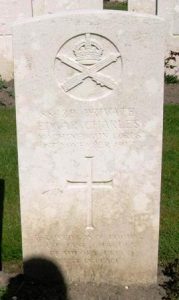
Thomas Coleman, Private, 267433, Monmouthshire Regiment. Thomas was the son of Henry and Harriett Coleman, of Naunton, Upton Upon Severn. He came to South Wales to find work as a collier and lodged at 27, North Street, Beaufort Hill, Beaufort prior to the war. Thomas enlisted into the 2/1st Brecknockshire Battalion, South Wales Borderers at Brynmawr on 12 October 1914 and was posted to Brecon. He remained on home service at Pembroke Dock until being drafted to France on 30 July 1916 and was transferred from the Infantry Base Depot at Rouen to the 2nd Battalion, Monmouthshire Regiment, which by then was the Pioneer Battalion to the 29th Division. He joined the battalion just after a move to Ypres from the Somme, where the Division was rebuilding following heavy losses. The 2nd Monmouth’s worked hard here on improving trenches and digging new communications trenches. The battalion then worked on the Menin Road, erecting elephant shelters, then on 4 October the Division was relieved and entrained south for the Somme once more, moving to Trônes Wood, before joining the latter stages of the Somme offensive. The Division wintered on the Somme, with the 2nd Monmouth’s working on road repairs around Montauban, then at Ginchy, Flers and Morval. The 2nd Monmouth’s moved into reserve at the end of December and moved to Fourdrinoy, where the men trained in infantry assault manoeuvres. On 12 January 1917 the battalion began marching back into the battle area, taking over positions near Morval, and began supplying working parties around Montauban once more. In the Spring of 1917, the Division fought at the Battle of the Scarpe, which was part of the Arras Offensive, seeing heavy fighting around Monchy-le-Preux, and then moved further north to Ypres, initially to hold the line whilst other units had been withdrawn for specialist training, in readiness for the Third Battle of Ypres, which opened on 31 July 1917. The 29th Division went into reserve whilst the first attacks, the Battle of Pilckem Ridge, took place, then on the night of 14-15 August moved into the line facing Langemarck, ready to launch another offensive. On the following day the battalion reconnoitred the ground in front of them, and laid white tapes in No Man’s Land, to guide the attacking troops, and at dawn on 16 August 1917 launched an attack on Langemarck. The Division then had another period out of the line to rest and refit before taking part in further fighting near Poelcapelle. Early in October 1917 the Division was relieved from the line at Ypres, and moved south to the Bellacourt area, to prepare to take part in the forthcoming Battle of Cambrai. The Division entrained for Péronne on 17 November, marching to a camp four miles out of the town at Haut Allaines, then by midnight on 18 November had reached Fins. On the following day the Division received its battle stores and detailed orders for the forthcoming battle, marching off via Gouzeaucourt to its assembly positions at Marcoing. The assault began at dawn on 20 November, but the Division suffered terrible casualties whilst attacking Masnières, on the Hindenburg Line. After wintering in the Cambrai sector, in January 1918 the 29th Division moved back to Ypres, taking up positions at Passchendaele Ridge again. To the south, the Germans launched the opening phase of their great offensive along the Somme front on 21 March 1918, then on 9 April launched the second phase along the Lys Valley. The 29th Division was relieved by the 41st Division that day and moved out of the line, before being rushed to positions at Les Haies Basses on the evening of 10 April. On the following morning the Division was hit by the Germans and the 29th Division was forced to withdraw, as they were flanked on the left. After being forced to revert to its role as infantry, once the fighting had died down, the 2nd Monmouth’s spent the coming weeks working on defences around L’Hoffand. Thomas was killed in action here whilst working in a wiring party on 3 May 1918. The 23-year-old is buried in Cinq Rues British Cemetery, Hazebrouck, France.
Thomas Coles, Private, 15352, South Wales Borderers. Thomas was the son of Thomas Coles and Mary Coles (nee Williams), of New Church Row, Aberystwyth. He had served with the South Wales Borderers for several years as a young man, after enlisting into the regiment at Brecon on 22 August 1893, and after leaving the army lived at Garn Row, Beaufort where he worked as a collier. Thomas then re-enlisted into the South Wales Borderers soon after the outbreak of war. He was initially stationed at Brecon until being posted to the 2nd Battalion, South Wales Borderers in January 1915. The battalion had just returned to England following service in China and had landed at Plymouth on 12 January 1915, entraining for Rugby to join 87 Brigade, 29th Division. On 17 March 1915 the battalion sailed from Avonmouth with the Division, arriving at Alexandria on 29 March, before moving to Mudros. On 25 April 1915 the Division landed at Cape Helles, Gallipoli, as part of the original landing force which had been despatched to try and seize the Dardanelles Straits and force Turkey out of the war. The invasion forces failed to break the Turkish defences and the campaign became bogged down. Thomas was killed in action near Gully Ravine on 19 June 1915. The 40-year-old has no known grave and is commemorated on the Helles Memorial, Gallipoli.
Graham Davies, Lieutenant, Royal Field Artillery. Graham was the son of William and Harriette Davies, of Minafon, Beaufort. He worked as an underground coal measurer prior to enlisting into the Welsh Divisional Royal Field Artillery in November 1914 and was posted to North Wales, where he was commissioned as Second Lieutenant, joining A Battery, 121st Brigade, Royal Field Artillery, which was a unit of the 38th (Welsh) Division. The Division began moving to France on 2 December 1915 and moved to the Nursery Sector near Fleurbaix for trench initiation alongside the Guards Division. The Division then held a sector of the line near Cuinchy before marching south to the Somme sector in June 1916 to take part in the assault on Mametz Wood. The first attack on the wood was launched on a two-battalion front on 7 July, but failed, and the Divisional Commander, Sir Ivor Philipps, was replaced before the Division attacked again on a two Brigade front on 10 July 1916. After two days of ferocious hand-to-hand fighting, the wood was cleared up to its northern edge, before the battered Division was relieved. It then took over a section of the front at Hébuterne before moving to the Ypres Salient and taking over the Canal Bank sector at Boesinghe. The infantry battalions of the Division then began carrying out the normal pattern of rotation in the trenches, four days in the front, four in support and four in reserve, whilst also working on trench improvement, digging new trenches, and carrying out regular patrols and trench raids. As the summer of 1917 dawned, the Division began preparing for the forthcoming Passchendaele offensive, being tasked with the capture of Pilckem Ridge. Graham was badly wounded during the build up to the offensive and died of his wounds on 27 July 1917. The 28-year-old was buried in Canada Farm Cemetery, Belgium.
Howell Henry Davies, Private, 213880, Border Regiment. Howell was the son of William Davies and Mercy Davies (nee Luff), of Rose Cottage, Beaufort Hill, Beaufort. He married Mary Harriett Withers, of 226, King Street, Brynmawr in 1913 and the couple set up home at 8, North Street, Beaufort hill, where Howell worked as a coal hewer. Howell enlisted into the Brecknockshire Battalion, South Wales Borderers at Brynmawr soon after the outbreak of war. Howell spent much of the war on home service and was posted to the Royal Defence Corps for a while before being drafted to France in the Spring of 1918 and was transferred to the 7th (Westmorland and Cumberland Yeomanry) Battalion, Border Regiment. The battalion was attached to 51 Brigade, 17th Division and had suffered heavy losses during the opening phase of the German Spring offensive in March 1918, when the Division took part in a gallant rear-guard action, withdrawing from Moeuvres towards Millencourt. After a period out of the line to rest and rebuild, the Division moved to the southernmost sector of the Somme area, where it fought at the Battle of Amiens on 8 August 1918, a day which saw the war swing in the favour of the Allies. The Allies then advanced on the Somme from 21 August, and the Division took part in this great offensive, driving towards the Hindenburg Line over the coming weeks, fighting at the Battle of Havrincourt on 12 September and the Battle of Épehy on 18 September. At the beginning of October, the mighty Hindenburg Line was broken, and the 17th Division swept towards Cambrai, fighting at the Battle of Cambrai on 8 October, and then continued to advance north-east through northern France, towards the old Battlefields of Mons and Le Cateau. On 19 October the 7th Border Regiment left Montigny to take up assembly positions prior to launching the next phase of their advance. At dawn on 20 October 1918 the battalion launched an assault against the Germans across the River Selle but became counter-attacked and in turn counter-attacked themselves. Howell was killed in action during the fighting that day. The 24-year-old is buried in Amerval Communal Cemetery Extension, Solesmes, France.
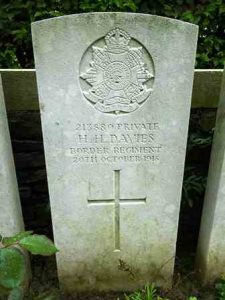
Stanley Davies, Lance Corporal, 20241, South Wales Borderers. Stanley was the son of Lewis Davies and Desdemona Davies (nee Phillips), of 5, Railway View, Beaufort. He worked as a coal hewer prior to enlisting into the 10th Battalion, South Wales Borderers at Ebbw Vale soon after the outbreak of war. The battalion was at Colwyn Bay attached to the 43rd (Welsh) Division. The Division trained in North Wales before moving to Winchester in the summer of 1915, where the formation became renumbered 113 Brigade, 38th (Welsh) Division. The Division began moving to France on 2 December 1915 and moved to the Nursery Sector near Fleurbaix for trench initiation alongside the Guards Division. The Division then held a sector of the line near Cuinchy before marching south to the Somme sector in June 1916 to take part in the assault on Mametz Wood. The first attack on the wood was launched on a two-battalion front on 7 July, but failed, and the Divisional Commander, Sir Ivor Philipps, was replaced before the Division attacked again on a two Brigade front on 10 July 1916. After two days of ferocious hand-to-hand fighting, the wood was cleared up to its northern edge, before the battered Division was relieved. It then took over a section of the front at Hébuterne before moving to the Ypres Salient and taking over the Canal Bank sector at Boesinghe. The infantry battalions of the Division then began carrying out the normal pattern of rotation in the trenches, four days in the front, four in support and four in reserve, whilst also working on trench improvement, digging new trenches, and carrying out regular patrols and trench raids. On 31 July 1917 the Division launched its famous assault on the Pilckem Ridge, capturing Iron Cross and reaching its objective of the Steenbeek, then played a supporting role in the Battle of Langemarck. The Division was transferred to the Sailly-sur-la-Lys sector in September and remained in the area over the winter before being moved to positions north of Albert, at Bouzincourt Ridge, at the end of March 1918, relieving the battered 2nd and 47th Divisions. It held this sector, again carrying out minor operations and trench raids, over the coming months. On 6 June the 10th SWB took over the front line in the Mesnil Sector, to begin a routine tour in the trenches. Stanley was killed in action here just before the battalion was relieved on 11 June 1918. The 23-year-old is buried in Engelbelmer Communal Cemetery Extension, France.
Gwillym Downs, Private, 20280, South Wales Borderers. Gwillym was the son of Edward James Downs and Margaret Downs (nee Hopkins), of 15, Beaufort Terrace, Beaufort. He lived at 8, Shop Row, Beaufort prior to the war and worked as a haulier above ground. Gwillym enlisted into the 10th Battalion, South Wales Borderers at Ebbw Vale soon after the outbreak of war. The battalion was at Colwyn Bay attached to the 43rd (Welsh) Division. The Division trained in North Wales before moving to Winchester in the summer of 1915, where the formation became renumbered 113 Brigade, 38th (Welsh) Division. The Division began moving to France on 2 December 1915 and moved to the Nursery Sector near Fleurbaix for trench initiation alongside the Guards Division. The Division then held a sector of the line near Cuinchy before marching south to the Somme sector in June 1916 to take part in the assault on Mametz Wood. The first attack on the wood was launched on a two-battalion front on 7 July, but failed, and the Divisional Commander, Sir Ivor Philipps, was replaced before the Division attacked again on a two Brigade front on 10 July 1916. After two days of ferocious hand-to-hand fighting, the wood was cleared up to its northern edge, before the battered Division was relieved. It then took over a section of the front at Hébuterne before moving to the Ypres Salient and taking over the Canal Bank sector at Boesinghe. The infantry battalions of the Division then began carrying out the normal pattern of rotation in the trenches, four days in the front, four in support and four in reserve, whilst also working on trench improvement, digging new trenches, and carrying out regular patrols and trench raids. Gwillym is shown in all surviving the records as having been killed in action on 28 June 1917. Both the 10th and 11th SWB were out of the line, training in readiness for the forthcoming assault on Pilckem Ridge during that period, so how he was killed is a mystery. The 41-year-old is buried in Bard Cottage Cemetery, Belgium. Interestingly, I have recently been contacted by a Belgian metal detectorist who has found Gwillym’s ID tag, and is looking to trace any relatives. See below:
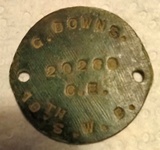
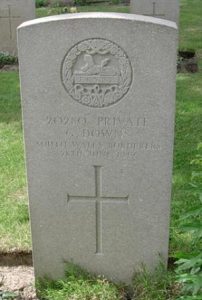
Albert Dunn, Private, 20380, South Wales Borderers. Albert was the son of William and Mary Dunn, of 2, Mount Pleasant Square, Bedwellty. He married Mary Jane Thomas in 1902 and the couple set up home at 2, Cross Row, Rassau. Albert worked as a coal hewer prior to enlisting into the 10th Battalion, South Wales Borderers at Ebbw Vale soon after the outbreak of war. The battalion was at Colwyn Bay attached to the 43rd (Welsh) Division. The Division trained in North Wales before moving to Winchester in the summer of 1915, where the formation became renumbered 113 Brigade, 38th (Welsh) Division. The Division began moving to France on 2 December 1915 and moved to the Nursery Sector near Fleurbaix for trench initiation alongside the Guards Division. The Division then held a sector of the line near Cuinchy before marching south to the Somme sector in June 1916 to take part in the assault on Mametz Wood. The first attack on the wood was launched on a two-battalion front on 7 July, but failed, and the Divisional Commander, Sir Ivor Philipps, was replaced before the Division attacked again on a two Brigade front on 10 July 1916. After two days of ferocious hand-to-hand fighting, the wood was cleared up to its northern edge, before the battered Division was relieved. It then took over a section of the front at Hébuterne before moving to the Ypres Salient and taking over the Canal Bank sector at Boesinghe. The infantry battalions of the Division then began carrying out the normal pattern of rotation in the trenches, four days in the front, four in support and four in reserve, whilst also working on trench improvement, digging new trenches, and carrying out regular patrols and trench raids. On 31 July 1917 the Division launched its famous assault on the Pilckem Ridge, capturing Iron Cross and reaching its objective of the Steenbeek, then played a supporting role in the Battle of Langemarck. Albert was badly wounded at Langemarck and was evacuated to a Casualty Clearing Station at Proven, where he died of his wounds on 17 August 1917. The 34-year-old was buried in Dozinghem Military Cemetery, Belgium.
Henry Edwards, Private, 288012, Royal Engineers. Henry was the son of John Phillip Edwards and Sarah Ann Edwards, of 6, Libanus Road, Ebbw Vale. He married Harriett Baker on 25 December 1912 and the couple set up home at 21, Gantra Place, Beaufort. Henry worked as a coal hewer prior to enlisting into the 3rd (Reserve) Battalion, Monmouthshire Regiment at Abergavenny on 20 October 1914. He remained on home service for over two years before embarking for France on 21 December 1916 and was posted from the Infantry Base Depot at Rouen to the 2nd Battalion, Monmouthshire Regiment on 5 January 1917. Upon joining the battalion, which was the Pioneer Battalion to the 29th Division, Henry was attached to the 180th Tunnelling Company, Royal Engineers. The Company was on the Somme, as was the 29th Division, and was hard at work on the Martinpuich Defences. The 180th TC then began work on the Assevillers Defences, before beginning work repairing roads and filling in a number of captured German dug outs and pits. Henry was wounded near Assevillers on 4 March 1917 and was evacuated to the 48th Casualty Clearing Station, suffering from gunshot wounds to his head, back and hip. He died of his wounds there two days later, on 6 March 1917. The 25-year-old is buried in Bray Military Cemetery, France.
John Thomas Edwards, Sergeant, 39059, South Wales Borderers. John was born at Tipton, Staffordshire on 27 July 1889, the son of Joseph Edwards and Elizabeth Edwards. John and his brother Joseph moved to Brynmawr as young men to find work as coalminers. John married Eliza Davies on 12 February 1912 and the couple set up home at Eagle Cottage, Beaufort Hill, Beaufort. John enlisted at Brynmawr into the South Wales Borderers and was drafted to France in the Spring of 1917, joining the 1st Battalion, South Wales Borderers, which was attached to 3 Brigade, 1st Division. The Division had followed the German retreat to the Hindenburg Line in early 1917 and was then briefed for an operation on the Flanders Coast, being relieved at the end of May 1917 and by the middle of June had taken over their new positions on the coast. While the Division was holding the line near Coxyde, the Passchendaele offensive was launched on 31 July 1917, but had got bogged down, so at the beginning of November the Division was transferred to Ypres, to join the great push for Passchendaele Ridge. The Division took up positions near Valour Farm, on the lower edge of the ridge, by 9 November and prepared to launch an assault on the following morning. The objectives were a series of ruined farms which had been fortified by the Germans and at dawn on 10 November 1917 the Division launched its assault. The men arose from the trenches and began to advance through thick mud, but the men got caught up in their own artillery barrage. John was killed in action at some time during the day. The 28-year-old has no known grave and is commemorated on the Tyne Cot Memorial, Belgium.
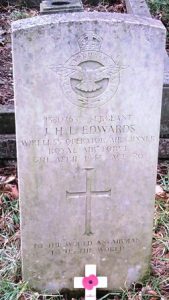
Albert George Fricker, Lance Bombardier, 29788, Royal Field Artillery. Albert was born at Radstock, Somerset on 16 March 1881, the son of George Fricker and Eliza Fricker. He had served with the Royal Field Artillery as a young man, and whilst based in The Barracks, Owlerton, Yorkshire, married Sarah Ellen Ashford on 26 February 1905. Albert then left the forces and the couple moved to 125, Beaufort Hill, Beaufort, where Albert had found work as a coal hewer. Following the outbreak of war, he re-enlisted at Brynmawr into the Royal Field Artillery. He originally embarked for the Middle East on 29 July 1915, probably serving at Gallipoli, but at some time afterwards was transferred to A Battery, 113th Brigade, Royal Field Artillery, which was in France. Albert was killed in action near Ypres on 4 October 1918. The 36-year-old is buried in Dadizeele New British Cemetery, Belgium.
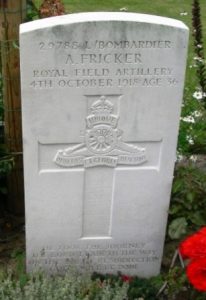
Lewis Griffiths, Private, 21290, South Wales Borderers. Lewis was the son of Walter and Mary Griffiths, of 4, Llangynidr Road, Beaufort. He worked as a coal miner prior to enlisting into the 10th Battalion, South Wales Borderers at Ebbw Vale soon after the outbreak of war. The battalion was at Colwyn Bay attached to the 43rd (Welsh) Division. The Division trained in North Wales before moving to Winchester in the summer of 1915, where the formation became renumbered 113 Brigade, 38th (Welsh) Division. The Division began moving to France on 2 December 1915 and moved to the Nursery Sector near Fleurbaix for trench initiation alongside the Guards Division. The Division then held a sector of the line near Cuinchy before marching south to the Somme sector in June 1916 to take part in the assault on Mametz Wood. The first attack on the wood was launched on a two-battalion front on 7 July, but failed, and the Divisional Commander, Sir Ivor Philipps, was replaced before the Division attacked again on a two Brigade front on 10 July 1916. Lewis is recorded as having been killed in action on 9 July 1916, the day before the main assault on the wood. The 10th SWB were in reserve bivouacs near Carnoy on that day, so the cause of his death is presently unknown. The 41-year-old has no known grave and is commemorated on the Thiepval Memorial, France.
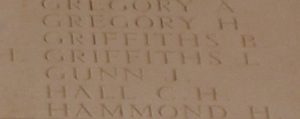
William Llewellyn Griffiths, Private, 14515, South Wales Borderers. William was the son of Elizabeth Griffiths, of 17, Beaufort Hill, Beaufort. He married Jane Morgan in 1904 and the couple set up home at the Farmers Arms, Beaufort. William worked as a coal miner prior to enlisting into the 5th Battalion, South Wales Borderers at Brecon soon after the outbreak of war. The battalion formed at Brecon in September 1914, before moving to Park House Camp, near Tidworth to join 58 Brigade, 19th (Western) Division. In December 1914 the battalion moved to Basingstoke in billets, then on 10 January 1915 became converted to the Pioneer Battalion for the 19th Division. The Division completed its training at Bulford and Perham Down, before embarking for France and landing at Le Havre on 16 July 1915. The entire 19th Division then moved to the Nursery Sector at Calonne for trench initiation alongside the Dehra Dun Brigade. The infantry battalions of the division then began carrying out the usual routines of rotating in the trenches: four days in the front line; four in support; and four in reserve, interspersed with training regimes and carrying out working parties and trench raids. Just south, the British launched a great offensive around the town of Loos on 25 September 1915, and the 19th Division was ordered to attack from its positions at the same time, to attempt to draw enemy attention away from the main battle area. The assault was a disaster, and heavy casualties were suffered by the 19th Division for no gain. The following year the Division moved to the Somme, where it took part in the second wave of the attack on Ovillers-La Boiselle on 1 July, capturing the village at heavy cost. It then fought through the Somme Battles of Pozieres and the Ancre in 1916. In 1917 the Division moved North to Ypres, taking part in the Battle of Messines. After a brief rest, where the Division rebuilt its strength, it then took part in the main Passchendaele offensive, which was launched on 31 July 1917. By October the Division had moved to the Merris area, and carried out several weeks of training whilst rebuilding, before moving south in the first week of December, taking over a section of the front line in the Ribecourt Sector. The Division wintered here, holding this sector over the coming months. At dawn on 21 March 1918 the Division was hit hard by the opening assault of the German Spring offensive, Operation Michael, and suffered terrible casualties during a fighting withdrawal over the coming days. The battered Division was relieved by the Australians, before being sent to the quieter Messines sector again on 30 March, to rest and rebuild. Unfortunately, the second phase of the German offensive, Operation Georgette, was launched along the Lys valley on 9 April, and the Division once more became embroiled in desperate fighting. William was killed in action when the Division was hit hard by the Germans on 11 April 1918. The 34-year-old has no known grave and is commemorated on the Ploegsteert Memorial, Belgium.
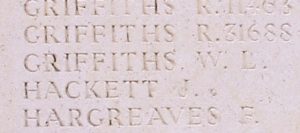
John Charles Hobbs, Private, 14485, South Wales Borderers. John was the son of Charles Hobbs and Margaret Hobbs (nee Davies), of 10, Pit Row, Ebbw Vale. He married Cecelia Ann Moores in 1906 and the couple set up home at Bridgend Building, Rassau, where their three daughters were born over the coming years. Cecelia died in childbirth in 1913, so two daughters went to live with Mrs Dobbs, at 1, Rock Cottage, Rassau, whilst the third went to live with Mrs Holman, at 2, Partridge Row, Beaufort. John enlisted at Brecon into the 5th Battalion, South Wales Borderers soon after the outbreak of war. The battalion formed at Brecon before moving to Park House Camp, near Tidworth, to join 58 Brigade, 19th (Western) Division. The men spent the winter in billets at Basingstoke, where in January 1915 the battalion became the Pioneer Battalion to the 19th Division. The Division began landing in France on 19 July 1915, then moved to the Nursery Sector at Calonne for trench initiation alongside the Dehra Dun Brigade. The infantry battalions of the division then began carrying out the usual routines of rotating in the trenches: four days in the front line; four in support; and four in reserve, interspersed with training regimes and carrying out working parties and trench raids. Just south, the British launched a great offensive around the town of Loos on 25 September 1915, and the 19th Division was ordered to attack from its positions at the same time, to attempt to draw enemy attention away from the main battle area. The attacking battalions of the 19th Division were in place by 04.00, and then at 05.50 the men climbed out of their trenches to launch their assault, behind a gas and smoke screen. The assault was a disaster, and heavy casualties were suffered by the 19th Division for no gain. The Division wintered on the Somme and in February followed the German withdrawal to the Hindenburg Line. During the middle of March 1917, the Division was relieved from the line and began to move north, taking over positions in the Ypres Salient, and on 7 June took part in the assault on Messines Ridge, which was famously preceded by the blowing of a series of 19 huge underground mines. The 19th Division saw heavy fighting during the battle, then enjoyed a short spell in reserve before moving back into the line on 11 September, taking over a section of trenches running from the Ypres-Comines Canal to Belgian Wood. On 20 September the Division attacked past Hollebeke Chateau, to Hessian Wood, suffering heavy casualties. The Division wintered in the Cambrai sector, following the closure of the Battle of Cambrai, and was holding a section of the line in the Flesquières Salient. On 21 March 1918 the Germans launched the first of three offensives on to the section of the front running from Flesquières to St. Quentin, and the 19th Division was thrown into desperate fighting as it was pushed back over the coming days. The battered Division was then moved to the Messines sector to rest, but on 11 April became caught up in the second phase of the German offensive, which had been launched along the Lys Valley on 9 April, and again became caught up in desperate fighting. The remnants of the Division were moved south to the Aisne sector to rest and rebuild, but by sheer bad luck, the Germans third, and last, offensive was launched here on 27 May 1918, and the Division was once more caught up in desperate fighting. At some time during these terrible months, John had been taken ill and been evacuated back to Britain. He was taken to the Lord Derby War Hospital at Warrington, where he died of cerebro-spinal fever on 6 June 1918. The remains of the 36-year-old were conveyed home and he was buried in St. David’s Churchyard, Beaufort.
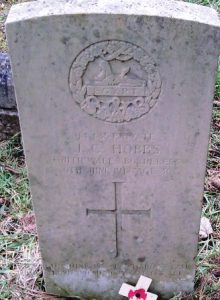
James Alfred Jones, MSM, Sergeant, 15688, South Wales Borderers. James was the son of John Jones and Mary Ann Jones, of 6, Williams Row, Beaufort. He worked as a coal miner prior to enlisting into the 7th Battalion, South Wales Borderers at Brecon soon after the outbreak of war. The battalion formed at Brecon in September 1914, before moving to Seaford to join 67 Brigade, 22nd Division. In December the battalion moved to St. Leonard’s in billets, then completed its training at Seaford and Aldershot before embarking for France and landed at Boulogne on 6 September 1915. The Division’s stay in France was to be very short, however, as on 27 October 1915 the Division, having been moved by train to Marseilles, began to embark for Salonika as part of an Anglo-French force sent to hold the Greek border, due to the invasion of neighbouring Serbia by a combined Austro-Bulgarian force. The Division remained in the Salonika theatre for the rest of the war, taking part in the Retreat from Serbia during December 1915. Large battles were fought in August 1916, at the battle of Horseshoe Hill, then in September 1916 at the battle of Machukovo. Between 24 April and 9 May 1917, the Division fought at the battle of Doiran, and then on 18 September 1918 at the Second Battle of Doiran. James was killed in action during the Second Battle of Doiran, on 18 September 1918. The 27-year-old is buried in Doiran Military Cemetery, Greece. James had been awarded the Meritorious Service Medal during his time in Salonika. The award was published in the London Gazette of 13 February 1917.
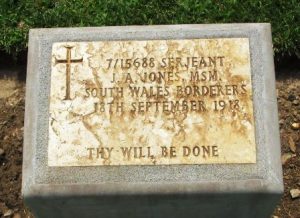
Evan William Lewis, Private, 19374, South Wales Borderers. Evan was the son of William Jarman Lewis and Mary Lewis, of 36, New Colliers Road, Ebbw Vale. He married Rose Hannah Isaacs on 13 June 1905 and the couple set up home at 2, South Street, Beaufort. Evan worked as a labourer prior to enlisting into the South Wales Borderers at Brynmawr on 24 March 1915. He was posted to the Depot at Brecon, where he joined the 3rd Battalion, South Wales Borderers, the regiments reserve unit, which was at Pembroke Dock. As he began his training it became apparent that Evan’s health was failing, and he was discharged from the army as medically unfit on 28 April 1915. He was too ill to return home and was taken to Pembroke Dock Military Hospital, where he died of tuberculosis on 9 May 1915. Nothing more is known of Evan, as he is not commemorated by the CWGC.
John McCrory, Private, 17585, South Wales Borderers. John was the son of Alexander McCrory and Emily McCrory (nee Thomas), of 126, King Street, Brynmawr. His father died in 1894, and after the turn of the century the family moved to The Fountain Inn, Tredegar. John worked as a coal miner in Beaufort prior to enlisting at Brynmawr into the 6th Battalion, South Wales Borderers soon after the outbreak of war. The battalion formed at Brecon in September 1914, moving to Codford to join 76 Brigade, 25th Division, before spending the winter in billets in Bournemouth. In February 1915 the battalion became the Pioneer Battalion to the 25th Division, before moving to Hursley Park and then to Tournay Barracks, Aldershot to complete its training. The battalion embarked for France and landed at Le Havre on 25 September 1915 before moving to the Vimy area with the Division, where they defended Vimy Ridge against a German attack in May 1916. They then moved to the Warloy area and attacked on 3 July near Thiepval. They fought throughout the Battle of the Somme, and then moved to Ploegsteert, where they held the line for the months leading up the Battle of Messines in June 1917. After fighting at Messines, the Division fought at the Pilckem Ridge, before moving south to the Arras Sector, taking up positions around Bullecourt in reserve. Here the Division was used to reinforce the badly depleted British units that were hit in the area by the German Spring Offensive of 21 March 1918. The Division then moved north to Flanders on the night of 30 March, where it took up positions at Ploegsteert again. On 9 April the Germans launched the second phase of their Spring Offensive along the Lys Valley, and the Division was caught up in the terrible fighting which ensued. The Division withdrew to Abeele to rest on 17 April, but on 25 April was ordered back into the line, and took part in the Second Battle of Kemmel. On 9 May the Division moved to Fismes, 20 miles south-east of Soissons in the Champagne, to give it a chance to rest and rebuild again. On 26 May the Division took up positions south of the Aisne, to guard against a predicted German Offensive. On the following morning, 27 May, the Germans hit the Division, and during the coming days the Division was virtually annihilated. The 6th SWB then transferred to the 30th Division, as the Divisional Pioneers. In August the Allies gained a huge victory over the Germans at Villers Bretonneux on the Somme, and from then on went on the offensive. The 30th Division, in Flanders, went on the offensive at the end of August and helped drive the Germans back towards Courtrai. John was wounded during this period and was evacuated to the 30th General Hospital at Calais, where he died of his wounds on 29 October 1918. The 32-year-old is buried in Les Baraques Military Cemetery, Sangatte, France.
Ernest Miles, Private, 2637, Monmouthshire Regiment. Ernest was the son of Henry and Mary Miles, of Odd Down, Bath. He lodged at 12, Glanyrafon Terrace, Beaufort prior to the war, where he worked as a coal hewer. Ernest enlisted into the 3rd Battalion, Monmouthshire Regiment at Abergavenny soon after the outbreak of war. The battalion mobilised at Abergavenny attached to the Welsh Border Brigade, Welsh Division, before moving to Pembroke Dock. On 10 August 1914 the Division moved to Oswestry before moving to Northampton, then spent Christmas at Bury St. Edmunds before moving to Cambridge. In February 1915 the 3rd Monmouth’s left the Welsh Division and landed in France on 14 February, before moving to the Ypres Salient. On 3 March 1915 the battalion joined 83 Brigade, 28th Division. On 8 April the 3rd Monmouth’s relieved a French Division in the sector east of the Polygon Wood to begin its first tour in the trenches. The battalion was relieved four days later, and marched to billets in Ypres, then on 17 April relieved the 5th King’s Own in the front line, to begin a spell which would last for 17 days without relief. On 22 April, just to the north, the Germans launched the first gas attack of the war upon French Colonial troops at Gravenstafel, heralding the opening of the Second Battle of Ypres. Ernest was killed in action near Polygon Wood on 2 May 1915, just prior to the wood being evacuated. The 25-year-old has no known grave and is commemorated on the Ypres (Menin Gate) Memorial, Belgium.
David James Morgan, Private, 58537, Lancashire Fusiliers. David was the son of Mary Elizabeth Morgan, of 6, South Street, Beaufort. He enlisted at Brecon into the army and was originally posted to the 4th (Reserve) Battalion, Welsh Regiment. Upon completing his training, David was drafted to France early in 1918 and was transferred to the 2/5th Battalion, Lancashire Fusiliers. The battalion was attached to 164 Brigade, 55th (West Lancs) Division and was holding the Gorre Sector, near Loos when David joined its ranks, after having been extensively rebuilt following severe losses at Cambrai the previous year. The Division faced numerous strong enemy raids in March, as the Germans were attempting to divert Allied attention away from the main battle area to the south, with their planned offensive, Operation Michael, being launched on the section of line running south from Croisilles to La Fère on 21 March 1918. April was at first much quieter, but it was a lull before the storm, as the Germans launched another offensive here on 9 April, and the 55th Division became embroiled in terrible fighting during the Battle of Éstaires, successfully fighting at the First Defence of Givenchy. David was wounded during two days of merciless enemy artillery fire onto the Divisions lines on 13/14 May and was evacuated to a Casualty Clearing Station at Pernes where he died of his wounds on 21 May 1918. The 20-year-old is buried in Pernes British Cemetery, France.
John Morris, Private, Deal 4388/S, Royal Marines. John was born on 7 July 1891, the son of William and Joanna Morris, of Linebridge Cottage, Rassau. He worked as a collier at the Tunnel Colliery, Ebbw Vale prior to enlisting into the Royal Naval Volunteer Reserve on 8 September 1915 and on 17 March 1916 was transferred to the Royal Marines Medical Unit. John was drafted to France on 11 May 1917 and was posted to the 2nd (Royal Naval) Field Ambulance, in the 63rd (Royal Naval) Division. The Division was at Arras and saw heavy fighting during the Battle of Arras, before moving north to Ypres in October to join the offensive for Passchendaele Ridge. John was killed at Passchendaele whilst carrying a wounded soldier from the battlefield on 26 October 1917. The 26-year-old is buried in Tyne Cot Cemetery, Belgium.
Richard Harold Page, Private, 8226, Herefordshire Regiment. Richard, known as Harold, was born on 10 August 1895, the son of John and Matilda Page of Rhayader. Following the death of his mother in 1904, Harold went to live with his grandparents, Richard and Eleanor Breeze, at Bryncoed, Llandrindod Wells, while his father moved to 42, Aberdare Road, Abercynon, where he worked as a Baker and Confectioner. Harold and his brother, Arthur Henry Page, then went to live at 6, Lower Square, Beaufort prior to the war after gaining work as coal miners. Harold returned to Rhayader to enlist into the 1/1st Battalion, Herefordshire Regiment soon after the outbreak of war. The battalion mobilised for war at The Barracks, Hereford, as part of the Welsh Border Brigade, Welsh Division and moved to its war station at Pembroke Dock. On 10 August the battalion moved to Oswestry, before joining the Welsh Division at Bedford in May 1915. The Division was then numbered the 53rd (Welsh) Division. On 19 July 1915 the entire Division sailed from Devonport for Imbros and on 9 August 1915 landed at Suvla Bay. The infantry moved off the beaches into the bush, but due to a lack of maps and no knowledge of the terrain, many of the units became disorientated, and the situation became chaotic. The situation settled down over the coming days, but was still precarious, with the Division coming under almost constant artillery and sniper fire. Harold was killed by a sniper at Suvla on 19 August 1915, aged 19. He is buried in Azmak Cemetery, Suvla, Gallipoli. Harold was a very popular man in the battalion, known as the ‘Wag’ of his Company, who was reported to be always cheerful and smiling, his death was felt keenly by his comrades.
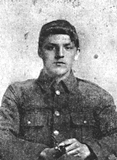
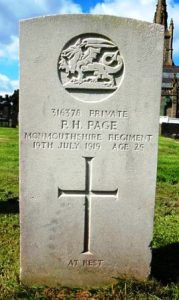
William Arthur Price, Private, 7924, South Wales Borderers. William was the son of John and Catherine Price, of Llangynidr. The family resided at the Castle Inn, Rassau by 1911 and William worked as a limestone tipper. He had enlisted into the South Wales Borderers Militia on 26 April 1898 and by the time war erupted was on the Army Reserve. William was mobilised on 4 August 1914 and was posted to the 1st Battalion, South Wales Borderers, which was at Bordon attached to 3 Brigade, 1st Division. William landed in France with the Division on 13 August 1914 and the Division then entrained for the Belgian frontier, near the town of Mons, joining the BEF. On 23 August 1914 the Germans attacked Mons in overwhelming force and the BEF was driven south, retreating over the coming days to the River Marne, where the German drive on Paris was halted. The Germans then withdrew to the heights of the Chemin-des-Dames ridge, to the north of the River Aisne, and the BEF advanced before attacking the German positions on 13 September. Neither side could gain any ground, despite ferocious fighting, so the BEF was ordered to dig in, thus beginning the first stages of the forming of the Western Front. William was killed in action during an artillery bombardment on the trenches held by the 1st SWB on 18 September 1914. The 34-year-old has no known grave and is commemorated on the La Ferté-Sous-Jouarre Memorial, France. His brother, Joseph, was killed at Gallipoli the following year.
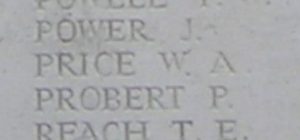
Albert James Priddy, Private, 3/5174, Duke of Cornwall’s Light Infantry. Albert was the son of Edward John Priddy and Jane Priddy (nee Owens), of Vale Avoca, Beaufort. He worked as a Mason’s Labourer prior to enlisting into the 3rd Battalion, Duke of Cornwall’s Light Infantry in London some years before the war. When war broke out, Albert was in Bodmin with the battalion, but was drafted to France on 1 November 1914, joining the 1st Battalion, Duke of Cornwall’s Light Infantry, which was attached to 14 Brigade, 5th Division. The Division had been in France since the outbreak of war, taking part in the Battle of Mons and the subsequent retreat to the Marne, then fought at the Battles of the Marne and the Aisne before moving to Flanders with the BEF. The Division fought at the Battle of La Bassée, then at Messines in October 1914. It fought here throughout the First Battle of Ypres, and took part in the capture of Hill 60, before taking part in the Second Battle of Ypres in April 1915. The Division remained at Ypres until March 1916, when it moved south to positions between St. Laurent-Blangy and Vimy, near Arras, and saw plenty of action during its spell there. Further south, on 1 July 1916 the Battle of the Somme opened, and the Division was relieved from Arras in the middle of July, before being transferred to the Somme. Albert was posted as missing, believed killed in action on the Somme on 23 July 1916. The battalion was not even in the line by then, so what happened to him is a mystery, but a note on one of his medal cards states that he was attached to the 18th Divisional Train, which was also on the Somme, heavily involved during the fighting throughout July. The 22-year-old has no known grave and is commemorated on the Thiepval Memorial, France.
Joe Seabourne, Private, 62690, Monmouthshire Regiment. Joe was the son of Eli Seabourne and Margaret Seabourne (nee Smith), of Gilwern, Llanelly. His father died before his birth, so Joe was raised by his mother at his eldest brother’s home at Llanelly. By 1901 he was working as a shop assistant at Llanelly, then by 1911 he was an inmate at the Crickhowell Union Workhouse and Infirmary but stated that he was married and that his former trade was of a limestone quarryman. Joe had enlisted into the Monmouthshire Regiment soon after the outbreak of war and was posted to Bedford with the 3rd (Reserve) Battalion. He was court martialled in Bedford, before being transferred to the 5th Battalion, South Wales Borderers and served on the Western Front at some time. Joe was then transferred to the 2nd Battalion, Monmouthshire Regiment. Little else is presently known of him, but Joe died at Herne Bay Military Hospital in Kent on 10 December 1918. The remains of the 36-year-old were brought home and he was buried in Ebbw Vale Cemetery.
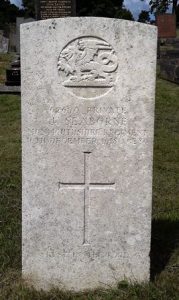
William Charles Stokes, Private, 67664, Cheshire Regiment. William was the son of William Stokes and Sarah Ann Stokes (nee Phillips), of Holly Bush Cottage, Rassau. He worked as a collier prior to enlisting into the 13th (Reserve) Battalion, South Wales Borderers at Abertillery on 21 August 1915 and joined the battalion at Kinmel Park. William lied about his age at enlistment, so remained in Kinmel Park for over a year before being transferred to the 59th Battalion, Training Reserve. He did not embark for France until 2 April 1918 and upon disembarkation joined the 9th Battalion, Cheshire Regiment, which was attached to 56 Brigade, 19th (Western) Division. The Division had suffered terrible casualties the previous month, following its heroic defence of Beugny and the ensuing withdrawal towards Hébuterne, following the opening phase of the German Spring offensive and had moved to positions near Ploegsteert to rest and refit. Unfortunately, on 9 April 1918 the Germans launched the second phase of their Spring offensive along the Lys Valley and the 19th Division was hit hard once more over the coming days. William was badly wounded during the first day of the fighting and was evacuated to the 2nd Canadian Casualty Clearing Station at Lijssenthoek, where he died of his wounds on 11 April 1918. The 18-year-old is buried in Lijssenthoek Military Cemetery, Belgium.
Sydney John Thomas, Private, 108853, Machine Gun Corps. Sydney was born in London on 18 November 1896, the son of John Thomas and Maria Thomas (nee Jones). His parents were both native of Breconshire, so when Sydney’s father died soon after his birth, his mother, Maria, moved back to Wales with her young family and set up home at 99, The Rise, Beaufort. Sydney enlisted into the Monmouthshire Regiment at Ebbw Vale in 1915, and after completing his training was transferred to the 28th Company, Machine Gun Corps. The Company was attached to the 9th (Scottish) Division and had formed in January 1916. The Company then took part in the Battle of the Somme, fighting at the opening Battle of Albert, and then at the Battle of Bazentin, where the 9th Division captured Longueval. The Division then fought at the Battle of Delville Wood, and the Battle of Le Transloy, before moving to Arras, where it fought at the First Battle of the Scarpe and the Third Battle of the Scarpe. The Division then moved north to Ypres, and fought at the Battle of the Menin Road, and at the First Battle of Passchendaele, before being moved to Cambrai, and fighting at the Action of Welsh Ridge. In February 1918 the British Army re-organised its Brigades and Machine Gun units, so Sydney was transferred to the 51st Battalion, Machine Gun Corps, in the 51st (Highland) Division. The Division was in the Cambrai sector when the Germans launched their Spring offensive on 21 March 1918 and saw heavy fighting as it was forced to withdraw over the coming days. Upon being relieved, the Division moved to Bethune to rest, unfortunately, the enemy opened a second phase of his offensive, now called the Battle of the Lys, on 9 April 1918 and the Highland Division moved into defensive positions behind Richebourg Saint Vaast, where it played a key part in beating off incessant attacks. At the beginning of May, the Division moved to Oppy near Arras, where it stayed until 11 July in a relatively quiet spell, however, when the Germans launched their third offensive of the year in the Aisne, the Division was sent south to assist. It saw several days of very heavy fighting, before the Germans were held and the Division then took part in a series of counterattacks. Sydney was wounded during a large-scale assault against Chaumuzy on 27 July 1918. He was taken to the 2/1st Highland Field Ambulance for treatment but died there of his wounds on 28 July 1918. The 21-year-old is buried in Marfaux British Cemetery, France.
Thomas Henry Titley, Private, 401116, Manchester Regiment. Thomas was the son of Isaac Titley and Emily Titley (nee Watkins), of Valley View, Beaufort. He married Blanche Emily Cooper in 1907 and the couple set up home at 3, Valley View, Beaufort. Thomas worked as a coal hewer prior to enlisting at Ebbw Vale into the 10th Battalion, South Wales Borderers soon after the outbreak of war. The battalion was training in North Wales attached to the 38th (Welsh) Division, however soon after arriving in North Wales, Sydney transferred into one of the regular battalions of the regiment and embarked for France on 3 April 1915. He must have been invalided home wounded at some point as upon his returned to France he transferred to the 1/8th Battalion, Manchester Regiment. The battalion was attached to 127 Brigade, 42nd (East Lancs) Division and had seen service at Gallipoli and in Egypt before moving to France in March 1917, taking over the line near Épehy then Havrincourt. In September the Division moved north to Ypres and fought during the early stages of the Third Battle of Ypres, until moving to the Coast in September to refit. November 1917 saw the Division moving to positions at Givenchy, where it remained until moving back south in early 1918. Here the Division faced the German Spring Offensive of 21 March on the Somme and fought a rear-guard action over the coming days whilst the British line was driven back. The fighting moved north on 9 April, when the Germans launched the second phase of their Spring offensive along the Lys Valley, and the 42nd Division took the chance to rebuild, whilst holding the line near Essars. On 7 April the 1/8th Manchester’s moved into the front line to begin a routine tour in the trenches, and two days later was relieved, before being moved by lorries into reserve billets at Henu. The battalion remained here until 15 April when it moved into reserve positions near Foncquevillers, remaining here until taking over the front line on 25 April, to begin another routine tour. Thomas was wounded soon afterwards and was evacuated to a nearby Casualty Clearing Station, at Gézaincourt. He died of his wounds there on the following day, 26 April 1918. The 30-year-old is buried in Bagneux British Cemetery, Gézaincourt, France.
Sidney Arthur James Vaughan, Private, 85696, Durham Light Infantry. Sidney was born at Ross, Herefordshire in 1899, the son of Sydney Vaughan and Jane Vaughan (nee Lambert). The family moved to Llantilio Crosseny by 1901, before moving again to 6, Waungoch Terrace, Beaufort. Sidney was a furnace worker prior to enlisting into the army at Abertillery on 16 December 1916 and was initially placed on the Army Reserve. He was mobilised at Cardiff on 17 April 1917 and was posted to the 2nd (Garrison) Battalion, Royal Welsh Fusiliers. Sidney remained on home service in Ireland until embarking for France on 27 June 1918 and was transferred to the newly arrived 29th Battalion, Durham Light Infantry, which was attached to 41 Brigade, 14th (Light) Division. The Division had been virtually annihilated in the Spring of 1918 and was forced to go back to England to rebuild. Upon its return it joined the Second Army and later that year took part in the great advance in Flanders. Sidney remained in the army in France after the war. On 7 May 1919 he was posted from the Infantry Base Depot at Étaples to the 20th Battalion, Durham Light Infantry and went to Germany with the Army of Occupation. Sidney took ill after over a year in Germany and died of nephritis and endocarditis in hospital at Cologne on 28 August 1919. The 20-year-old is buried in Cologne Southern Cemetery, Germany.
Tom James Williams, Private, 13016, South Wales Borderers. Tom was the son of William and Louisa Williams, of 3, Holly Bush Row, Rassau. He worked as a collier prior to enlisting at Newport into the 4th Battalion, South Wales Borderers soon after the outbreak of war. The battalion formed at Brecon, before moving to Park House Camp, near Tidworth to join 40 Brigade, 13th (Western) Division, then moved to billets in Cirencester before moving to Woking in March 1915 for final training. On 29 June 1915 the Division sailed from Avonmouth for Mudros, before landing at Cape Helles, Gallipoli on 15 July 1915. Two weeks later the Division was moved to Anzac, to reinforce the Australian and New Zealand troops there, in readiness for a great assault on the Sari Bair Ridge, in conjunction with fresh Allied landings at Suvla Bay. The assault began on 6 August 1915 and raged over the coming days. The 4th SWB reached the Achyl Dere before assaulting, and seizing Damakjelik Bair, one of the ridges held by the Turks. The Turks counter-attacked on 9 August and terrible fighting raged throughout the day. Tom was wounded during the day and was evacuated to the 7th Field Ambulance, where he died of his wounds on 10 August 1915. The 28-year-old is buried in the 7th Field Ambulance Cemetery, Gallipoli.
Bertram Willing, Private, 48247, Welsh Regiment. Bertram was the son of George Willing and Diana Willing (nee Jenkins), of Greenfield House, Wesley Place, Beaufort. He worked as a coal haulier above ground prior to the war. Bertram enlisted into the army at Ebbw Vale and after completing his training was posted to Salonika, joining the 11th Battalion, Welsh Regiment, which was attached to 67 Brigade, 22nd Division. The Division had been transferred from the Western Front to Salonika as part of an Anglo-French force in October 1915, to help guard the Greek frontier following the invasion of Serbia by a combined Austro-Bulgarian offensive. The Division remained in the theatre for the rest of the war, taking part in the Retreat from Serbia during December 1915, and took part in a number of pitched battles over the coming years. Between 10 to 18 August 1916, they Division fought at the battle of Horseshoe Hill, then between 13 to 14 September 1916 at the battle of Machukovo. Between 24-25 April and 8-9 May 1917, the Division fought at the battle of Doiran. Bertram was killed in action after the cessation of the latter battle, on 27 May 1917. The 26-year-old is buried in Karasouli Military Cemetery, Greece.